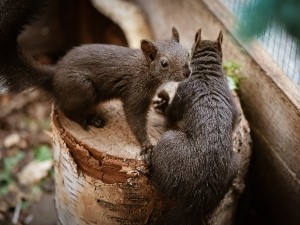
A squirrels twitchy, fidgety behaviour often gives the sense of unease and that it’s ready to run. If you’ve ever wondered why squirrels are so twitchy then you’ve come to the right place, this article offers the answer. Whether you’re a squirrel lover, squirrel owner or are simply curious this article will help you understand why squirrels are so twitchy.
Squirrels are usually twitchy in their tails. This twitchiness is not only a sign that the squirrel is getting ready to run away from you but it is also a method of communicating to other squirrels. It communicates that there is a predator in the area, it is a method of communicating to potential mates and it confuses predators
Table of Contents
Why are squirrels so twitchy?
The twitchy behaviours of squirrels do more than just warn you that they’re preparing to run away if you come any closer, also it communicates a wide range of silent messages to other squirrels.
Twitchy squirrels may communicate to us humans that they are anxious, nervous, apprehensive, and about to scurry away if we come any closer. But, to their fellow squirrels, it’s much more than that.
Squirrels twitch and jerk their tails in a variety of ways to communicate danger to onlooking squirrels. Also, the twitching communicates messages such as different levels of danger, it confuses predators, communicates their location to other squirrels across long distances, and the twitching even attracts the desired mate during mating season.
They also jerk their tails occasionally to keep their balance while upright, running in trees and taking risky leaps. With so many patterns of twitching and jerking their tails, it’s no wonder they confuse predators.
Why do squirrels chatter their teeth?
The chattering of teeth is useful to squirrels as a means of distracting and deterring predators or nosy onlookers. The clickity click of sharp teeth, presumably getting ready to chomp away at you, can deter the interest of an oncoming predator. The noise can also become an irritation, turning away annoyed onlookers. This activity is also one way that the animal maintains its teeth.
Why is a squirrel making weird noises?
These animals have a range of noises that they make, for example, a toothy chirp usually means “hey you there, this is mine and my territory, you better back off of else…” Ok, I may be exaggerating here, but you get the gist.
The weird noises and chatter are usually loudest during mating months February, March, June, and July. It’s their romantic call to another squirrel to say “hey gorgeous fluffy tail I’m interested…” The calls set the mood for swooning their beloved mate.
How to calm a squirrel down?
Two riled up persons can’t make the other calm so first things first, be sure you are calm. Animals are perceptive and can sense our emotions. If the squirrel is your domesticated pet, then gently rub its furry coat beneath its neck and then it’s back for a minute or two, that usually works.
If it’s a wild squirrel, retreat from its territory. Be mindful that wild animals will lash out so exercise caution. Offering a snack or tasty treat can make amends especially for a wild squirrel but best be safe and stay away while they are riled up.
Conclusion:
In conclusion, squirrels are usually twitchy in their tails. This twitchiness is not only a sign that the squirrel is getting ready to run away from you but it’s also is a method of communicating to other squirrels.
It confuses predators, is a method of communicating to potential mates and it communicates that there is a predator in the area. Chattering their teeth can also distract predators. The weird noises that they make are other ways of communicating dominance or romantic interest in another squirrel.
If you enjoyed this article then you may also be interested in other squirrel related articles. Here are some articles that you may be interested in: Do squirrels eat fish?, Why does my squirrel nibble on me?, Do squirrels attack rabbits?, Do squirrels eat dog food?

